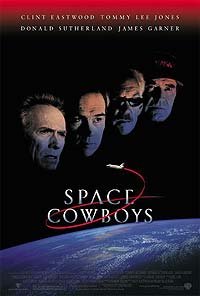Space Cowboys |
      • Directed by: Clint Eastwood. • Starring: Clint Eastwood, Tommy Lee Jones, Donald Sutherland, James Garner, James Cromwell, Marcia Gay Harden, William Devane, Loren Dean, Courtney B. Vance, Barbara Babcock, Rade Serbedzija, Blair Brown, Jay Leno. • Music by: Lennie Niehaus. • Directed by: Clint Eastwood. • Starring: Clint Eastwood, Tommy Lee Jones, Donald Sutherland, James Garner, James Cromwell, Marcia Gay Harden, William Devane, Loren Dean, Courtney B. Vance, Barbara Babcock, Rade Serbedzija, Blair Brown, Jay Leno. • Music by: Lennie Niehaus.      Frank Corvin, "Hawk" Hawkins, Jerry O'Neill and Tank Sullivan were hotdog members of Project DAEDALUS, the Air Force's test program for space travel. Their hopes were dashed in 1958 with the formation of NASA and the use of trained chimps. They blackmail their way into orbit when Russia's mysterious Ikon communications satellite's orbit begins to degrade and threatens to crash into Earth. Frank Corvin, "Hawk" Hawkins, Jerry O'Neill and Tank Sullivan were hotdog members of Project DAEDALUS, the Air Force's test program for space travel. Their hopes were dashed in 1958 with the formation of NASA and the use of trained chimps. They blackmail their way into orbit when Russia's mysterious Ikon communications satellite's orbit begins to degrade and threatens to crash into Earth.
|
Trailers:
| Length: | Languages: | Subtitles: |
Review:
















It is implied that, once the spaceship was closer to the Moon than the Earth, namely just past halfway through their journey, the greater gravitational field of the Moon would cause him to fall towards it rather than towards the Earth. This, however, is manifestly untrue, due to the significantly greater mass of the Earth than the Moon. Given that the Earth's mass is approximately 80 times that of the Moon and gravitational field strength is directly proportional to mass and inversely proportional to distance squared, it is a simple mathematical exercise to show that the point where the two field strengths are equal is actually the square root of 80 (approximately 9) times further from Earth than the Moon. In other words, the spaceship would need to be 90% of the way from the Earth to the Moon, with only 10% of the distance still to go, before the gravitational 'pull' of the Moon upon an object exceeds that of the Earth's 'pull'.
A simple analogous comparison can be made between this and the gravitational attraction on Earth compared with that of a small permanent magnet. Because the former is much stronger than the latter, a small iron paper clip, on Earth, would fall downwards rather than 'leap' upwards towards a small magnet held 1 metre above it. If, however, the magnet was only 1 centimetre above the paper clip, instead of 1 metre, the greater strength of the magnetic field, due to the smaller distance between the magnet and the paper clip, than the gravitational field exerted by the Earth would cause it to move upwards.
Therefore, the spaceship needed to be much closer to the Moon - and therefore further from the Earth - for Hawk's fall to be physically possible, but I assume that this would not have fitted in with the simple 'oh they are halfway there - that will be close enough!' idea employed in the movie.
This leads onto a second problem that I have with this part of the movie: Hawk's landing on the surface of the Moon. He uses an escape pod with no apparent facility to control its rate of descent to travel in, which would make the experience similar to plummeting towards the surface of the Earth without a parachute. On the positive side, the Moon is lighter than the Earth, so the rate of acceleration during the descent would be less than if the mass of the Moon was equal to that of the Earth; however, on the negative side, as the Moon has no atmosphere, there would be no air resistance to act against the acceleration caused by this gravitational attraction. There would therefore be no terminal velocity reached and Hawk's craft would probably hit the surface of the Moon harder than if he had fallen and landed - without the benefit of a parachute - from an aeroplane 10 miles above the Earth's surface. A much faster death, admittedly, than slow death by cancer, but not the version shown at the end of the movie!
In fantasy or Sci-Fi movies I am happy for the laws of science to be modified, and for wormholes in time, spaceships moving at warp speed and men able to fly wearing red capes to proliferate, but for a plot ostensibly set in the 'real' world - Armstrong, Glenn and Shepard all get a name check after all! - the 'real' laws of science need to be obeyed for the story to be credible. In my opinion, when this is not the case the movie as a whole suffers as a consequence.
Review by Stanley Jackson from the Internet Movie Database.
Movie Database